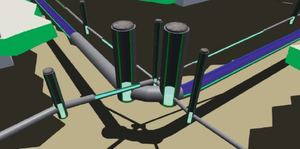Information
- Publication Type: Bachelor Thesis
- Workgroup(s)/Project(s):
- Date: May 2017
- Date (Start): 10. August 2016
- Date (End): 2. May 2017
- Matrikelnummer: 0806024
- First Supervisor:
Abstract
Visualizing the results of a flood simulation interactively in real-time has become very important due to the increasing number of flood hazards in the recent past. An important part of a flood simulation is the impact on the sewer system of the flooded city. For the simulation itself only a very primitive data structure of a sewer system is required. Therefore this thesis proposes an innovative and efficient technique to render sewage pipes and to visualize the water flow inside of them. With a simple underlying data structure of node positions, billboarded sewage pipes are constructed in the geometry shader. With a proxy geometry the stencil buffer is utilized to distinguish outside and inside of the pipe and the billboards are drawn accordingly. In addition another technique is introduced to cut-open the occluding terrain to expose the sewage pipes to the viewer. Therefore a two dimensional distance transform of the sewer network is generated. The created distance field is used to discard fragments of the terrain, which are relatively close to a pipe. Further an artificial thickness is added to the cut-open terrain analytically in image-space. The techniques are presented in detail and their implementation is demonstrated in Unity3D. It is evaluated by comparing the result to multiple conventions for computer generated cutaways. Additionally the feedback from visualization experts and the technical performance is presented. The results show that billboarded and cut-open tubular geometry can be rendered fast, efficient and with a low memory footprint. Furthermore the technique fulfills many of the design principles for cutaways and got positive feedback from visualization experts.Additional Files and Images
Weblinks
BibTeX
@bachelorsthesis{Matusich-2017-01,
title = "Billboarded Cutaway Visualization for Subsurface Urban Sewer
Networks - Flood Simulation embedded in Unity3D",
author = "Manuel Matusich",
year = "2017",
abstract = "Visualizing the results of a flood simulation interactively
in real-time has become very important due to the increasing
number of flood hazards in the recent past. An important
part of a flood simulation is the impact on the sewer system
of the flooded city. For the simulation itself only a very
primitive data structure of a sewer system is required.
Therefore this thesis proposes an innovative and efficient
technique to render sewage pipes and to visualize the water
flow inside of them. With a simple underlying data structure
of node positions, billboarded sewage pipes are constructed
in the geometry shader. With a proxy geometry the stencil
buffer is utilized to distinguish outside and inside of the
pipe and the billboards are drawn accordingly. In addition
another technique is introduced to cut-open the occluding
terrain to expose the sewage pipes to the viewer. Therefore
a two dimensional distance transform of the sewer network is
generated. The created distance field is used to discard
fragments of the terrain, which are relatively close to a
pipe. Further an artificial thickness is added to the
cut-open terrain analytically in image-space. The techniques
are presented in detail and their implementation is
demonstrated in Unity3D. It is evaluated by comparing the
result to multiple conventions for computer generated
cutaways. Additionally the feedback from visualization
experts and the technical performance is presented. The
results show that billboarded and cut-open tubular geometry
can be rendered fast, efficient and with a low memory
footprint. Furthermore the technique fulfills many of the
design principles for cutaways and got positive feedback
from visualization experts.",
month = may,
address = "Favoritenstrasse 9-11/E193-02, A-1040 Vienna, Austria",
school = "Institute of Computer Graphics and Algorithms, Vienna
University of Technology ",
URL = "https://www.cg.tuwien.ac.at/research/publications/2017/Matusich-2017-01/",
}

 Bachelor Thesis
Bachelor Thesis image
image

